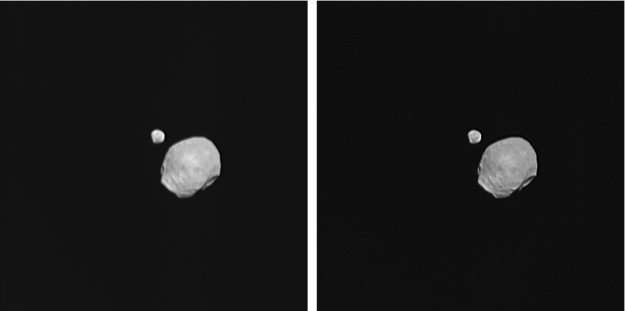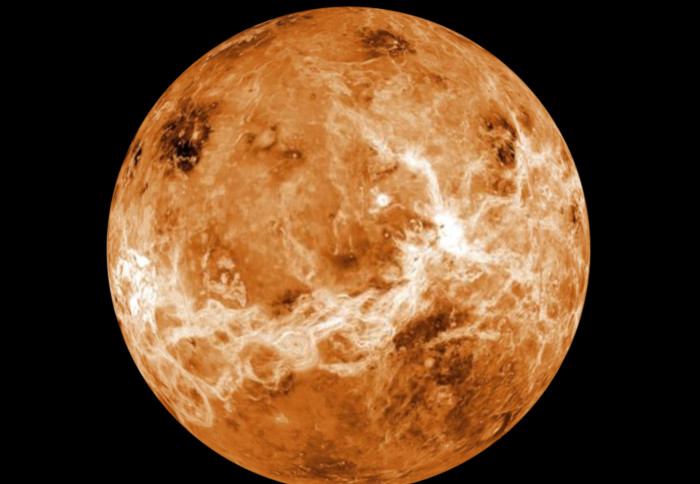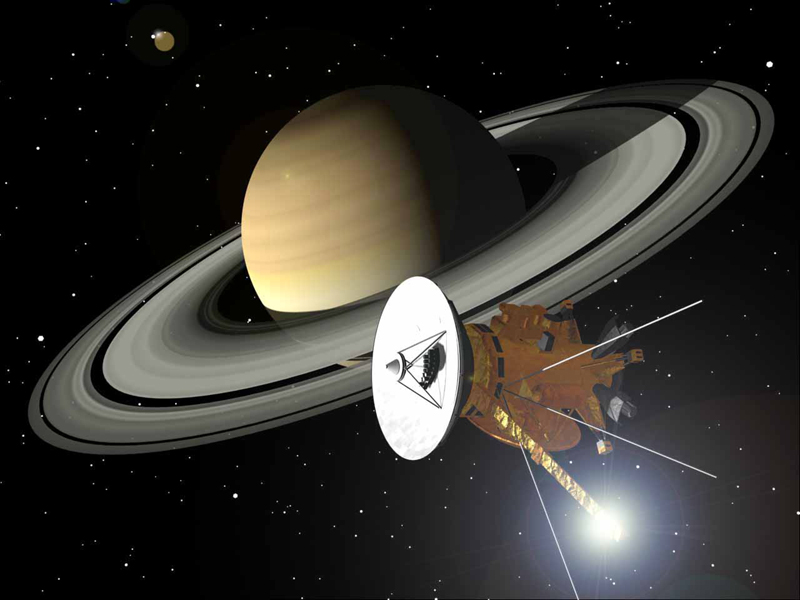Moons of Mars - Deimos

Phobos and Deimos (the small moon) captured together by ESA’s Mars Express Orbiter. [Credit: ESA/DLR/FU Berlin]
By the late 19th century astronomers had discovered moons orbiting Jupiter, Saturn, Uranus and Neptune. However no one had found any Martian moons – until 1877. That's when American astronomer Asaph Hall surprised the world by discovering two Martian moons. Why did it take so long to find them? And why were they given the names Phobos and Deimos, meaning fear and terror?
Ares
The names for Mars's moons came from ancient Greece. Mars is the Roman equivalent of Ares, the Greek god of war. In Greek mythology Phobos (FOE.bus) and Deimos (DI-məs) were the war god's sons. They went into battle with him, driving his chariot and spreading panic. Even today if you have a great fear of something like heights or spiders, it's called a phobia.
Why did it take so long to find the moons?
The moons are close to the planet. Before Asaph Hall's search no one had looked for moons so close to the surface of Mars. Phobos is about 9400 km (5800 mi) and Deimos 23,500 km (14,600 mi) from Mars. Our Moon orbits at about 384,000 km (240,000 miles), and Io, the nearest large moon to Jupiter, is about that same distance away from the giant planet. Hall's double discovery was a sensation to the public as well as the world of astronomy.
About Deimos
Neither of the Martian moons is massive enough for gravity to have collapsed it into a spherical shape. They're both small, irregular, lumpy and cratered. Deimos is much smaller than Phobos, with dimensions about 10x12x16 km (6x8x10 mi). Think about a space the size of, say, New York City. Deimos would only take up about a quarter of it, though its height would dwarf even the tallest skyscrapers.
Deimos, as you can see in the header image, is reddish and seems to have a fairly smooth surface. [NOTE: the color in the image from Mars Reconnaissance Orbiter has been enhanced.] The moon's surface isn't icy smooth like Saturn's moon Enceladus. It's covered by fine rock fragments known as regolith which smooths over all but fairly recent impacts. Two of the craters have names. They are Swift and Voltaire, two literary figures that referred to Martian moons in works of fiction that predated Hall's discovery.
A meteorite hitting our Moon sends material flying upward which then drops back down. The material is called ejecta and it's the source of regolith on the Moon and other bodies. However Deimos has a very low escape velocity. Just 20 km/h (13 mph) would get you off the little moon, and most impact material that flies up into the air just keeps on going. This doesn't mean that meteorites hitting Deimos just bounce off. They are the source of Deimos's regolith when they're smashed to bits as they hit the surface.
Deimos in orbit
Deimos and Phobos are both in circular orbits above the Martian equator. They're also tidally locked to Mars. This means that, like our own Moon, each one rotates once on its axis in the time it takes to orbit the planet. However instead of taking nearly thirty days, Deimos takes just over thirty hours to complete its orbit.
Imagine being on Mars and looking up at Deimos. You couldn't see it at all from the polar regions, because Deimos is close to Mars and in a nearly circular orbit. Near the poles, the curve of Mars would hide its moon. In addition, even when Deimos is full, you wouldn't see a disk. The moon is so small that it would just look like a bright point of light.
We are used to a Moon that circles at a fairly leisurely pace, gradually going through its phases over nearly thirty days. Deimos takes just over thirty hours to get around Mars, and at 24 hours and 37 minutes, a Martian day isn't much longer than an Earth day.
As our Moon does, Deimos rises in the east. The similarity ends there. Since it's orbiting Mars only slightly faster than Mars is rotating, Deimos would appear to move very slowly across the sky. Overall moonrise to moonset would take less than three days. Deimos would rise one evening and move slowly across the sky until it was lost in Mars's shadow on the second night. It would finally set at dawn on the third night.
Questions
But what do we know about the other Martian moon Phobos? And how were these strange little moons formed? People had assumed for a long time that they were captured asteroids, but evidence gathered by space probes suggests otherwise, but astronomers are still not in complete agreement. Click on the link below this article to find out more about Phobos.
Credit:
Explanation of the apparent motion of Deimos: William K. Hartmann, Ron Miller, Out of the Cradle: Exploring the Frontiers Beyond Earth
By the late 19th century astronomers had discovered moons orbiting Jupiter, Saturn, Uranus and Neptune. However no one had found any Martian moons – until 1877. That's when American astronomer Asaph Hall surprised the world by discovering two Martian moons. Why did it take so long to find them? And why were they given the names Phobos and Deimos, meaning fear and terror?
Ares
The names for Mars's moons came from ancient Greece. Mars is the Roman equivalent of Ares, the Greek god of war. In Greek mythology Phobos (FOE.bus) and Deimos (DI-məs) were the war god's sons. They went into battle with him, driving his chariot and spreading panic. Even today if you have a great fear of something like heights or spiders, it's called a phobia.
Why did it take so long to find the moons?
The moons are close to the planet. Before Asaph Hall's search no one had looked for moons so close to the surface of Mars. Phobos is about 9400 km (5800 mi) and Deimos 23,500 km (14,600 mi) from Mars. Our Moon orbits at about 384,000 km (240,000 miles), and Io, the nearest large moon to Jupiter, is about that same distance away from the giant planet. Hall's double discovery was a sensation to the public as well as the world of astronomy.
About Deimos
Neither of the Martian moons is massive enough for gravity to have collapsed it into a spherical shape. They're both small, irregular, lumpy and cratered. Deimos is much smaller than Phobos, with dimensions about 10x12x16 km (6x8x10 mi). Think about a space the size of, say, New York City. Deimos would only take up about a quarter of it, though its height would dwarf even the tallest skyscrapers.
Deimos, as you can see in the header image, is reddish and seems to have a fairly smooth surface. [NOTE: the color in the image from Mars Reconnaissance Orbiter has been enhanced.] The moon's surface isn't icy smooth like Saturn's moon Enceladus. It's covered by fine rock fragments known as regolith which smooths over all but fairly recent impacts. Two of the craters have names. They are Swift and Voltaire, two literary figures that referred to Martian moons in works of fiction that predated Hall's discovery.
A meteorite hitting our Moon sends material flying upward which then drops back down. The material is called ejecta and it's the source of regolith on the Moon and other bodies. However Deimos has a very low escape velocity. Just 20 km/h (13 mph) would get you off the little moon, and most impact material that flies up into the air just keeps on going. This doesn't mean that meteorites hitting Deimos just bounce off. They are the source of Deimos's regolith when they're smashed to bits as they hit the surface.
Deimos in orbit
Deimos and Phobos are both in circular orbits above the Martian equator. They're also tidally locked to Mars. This means that, like our own Moon, each one rotates once on its axis in the time it takes to orbit the planet. However instead of taking nearly thirty days, Deimos takes just over thirty hours to complete its orbit.
Imagine being on Mars and looking up at Deimos. You couldn't see it at all from the polar regions, because Deimos is close to Mars and in a nearly circular orbit. Near the poles, the curve of Mars would hide its moon. In addition, even when Deimos is full, you wouldn't see a disk. The moon is so small that it would just look like a bright point of light.
We are used to a Moon that circles at a fairly leisurely pace, gradually going through its phases over nearly thirty days. Deimos takes just over thirty hours to get around Mars, and at 24 hours and 37 minutes, a Martian day isn't much longer than an Earth day.
As our Moon does, Deimos rises in the east. The similarity ends there. Since it's orbiting Mars only slightly faster than Mars is rotating, Deimos would appear to move very slowly across the sky. Overall moonrise to moonset would take less than three days. Deimos would rise one evening and move slowly across the sky until it was lost in Mars's shadow on the second night. It would finally set at dawn on the third night.
Questions
But what do we know about the other Martian moon Phobos? And how were these strange little moons formed? People had assumed for a long time that they were captured asteroids, but evidence gathered by space probes suggests otherwise, but astronomers are still not in complete agreement. Click on the link below this article to find out more about Phobos.
Credit:
Explanation of the apparent motion of Deimos: William K. Hartmann, Ron Miller, Out of the Cradle: Exploring the Frontiers Beyond Earth
You Should Also Read:
Moons of Mars - Phobos
Packing for Mars - book review
Beagle 2 - Lost and Found

Related Articles
Editor's Picks Articles
Top Ten Articles
Previous Features
Site Map
Content copyright © 2023 by Mona Evans. All rights reserved.
This content was written by Mona Evans. If you wish to use this content in any manner, you need written permission. Contact Mona Evans for details.







